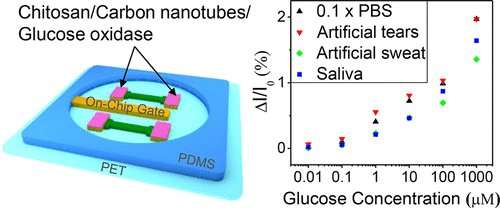New biosensor could monitor glucose levels in tears and sweat

Constantly tracking a person's glucose levels through their tears or sweat could be one step closer to providing people with diabetes an improved monitoring tool. Researchers report in the journal ACS Nano the development of an ultra-thin, flexible sensor that could be incorporated into contact lenses or on the backs of watches for real-time glucose tracking.
Wearable sensors are part of an increasingly digitized world. But those that are commercially available typically monitor physical activities by measuring steps taken, for example, or heart rate. Creating ways to measure health markers on a molecular level has been far more challenging, but the benefits could be life-changing for some. Diagnosing and tracking conditions are often done by analyzing a sample of someone's blood. The pain of pricking fingers or drawing blood, however, can deter people from vigilantly monitoring conditions such as diabetes that require regular checks. To take the sting out of the process, wearable glucose sensors are in development but have been hampered by several factors. Some devices can't detect the low levels of glucose that are in sweat and tears, or they stop working when they're bent. Moh Amer, Chongwu Zhou and colleagues wanted to tackle these issues.
The researchers created a biosensor using nanoribbons of indium oxide, an enzyme glucose oxidase, a natural chitosan film and single-walled carbon nanotubes. When glucose is present in a test sample, it interacts with the enzyme, setting off a short chain of reactions and ultimately creating an electrical signal. Testing showed that the device could detect a range of glucose concentrations from 10 nanomolar to 1 millimolar, which is sensitive enough to cover typical glucose levels in sweat, saliva and tears in people with and without diabetes. Bending the film 100 times didn't noticeably affect its performance. In addition to glucose tracking, the researchers suggest that the sensor could also be used for monitoring in the food and environmental sectors.
More information: Qingzhou Liu et al. Highly Sensitive and Wearable In2O3 Nanoribbon Transistor Biosensors with Integrated On-Chip Gate for Glucose Monitoring in Body Fluids, ACS Nano (2018). DOI: 10.1021/acsnano.7b06823
Abstract
Nanoribbon- and nanowire-based field-effect transistor (FET) biosensors have stimulated a lot of interest. However, most FET biosensors were achieved by using bulky Ag/AgCl electrodes or metal wire gates, which have prevented the biosensors from becoming truly wearable. Here, we demonstrate highly sensitive and conformal In2O3 nanoribbon FET biosensors with a fully integrated on-chip gold side gate, which have been laminated onto various surfaces, such as artificial arms and watches, and have enabled glucose detection in various body fluids, such as sweat and saliva. The shadow-mask-fabricated devices show good electrical performance with gate voltage applied using a gold side gate electrode and through an aqueous electrolyte. The resulting transistors show mobilities of ∼22 cm2 V–1 s–1 in 0.1× phosphate-buffered saline, a high on–off ratio (105), and good mechanical robustness. With the electrodes functionalized with glucose oxidase, chitosan, and single-walled carbon nanotubes, the glucose sensors show a very wide detection range spanning at least 5 orders of magnitude and a detection limit down to 10 nM. Therefore, our high-performance In2O3 nanoribbon sensing platform has great potential to work as indispensable components for wearable healthcare electronics.
Journal information: ACS Nano
Provided by American Chemical Society




















